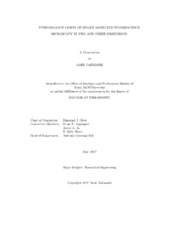| dc.contributor.advisor | Ober, Raimund J | |
| dc.creator | Tahmasbi, Amir | |
| dc.date.accessioned | 2017-08-21T14:31:41Z | |
| dc.date.available | 2017-08-21T14:31:41Z | |
| dc.date.created | 2017-05 | |
| dc.date.issued | 2017-01-04 | |
| dc.date.submitted | May 2017 | |
| dc.identifier.uri | https://hdl.handle.net/1969.1/161278 | |
| dc.description.abstract | Photon-limited imaging is a core tool for the acquisition of precise quantitative data in a wide range of scientific endeavors, where parameters of an experiment are estimated. An important example is single molecule fluorescence microscopy, a relatively new optical microscopy technique that allows the detection of individual molecules such as proteins in a cellular context. One of the central aspects of such photon-limited imaging systems concerns the lowest possible variance with which an unknown parameter, e.g. the location of an object, can be estimated. The Cramér–Rao Lower Bound (CRLB) on the variance of unbiased estimators is widely used to assess the performance limits of imaging systems. However, the current approach for the calculation of the CRLB relies on an analytical expression for the image of the object. This can pose practical challenges since it is typically difficult to find appropriate analytical models for the images of general objects. Here, we instead develop an approach that directly uses an experimentally collected image set to calculate the CRLB for the location of a general object. In this approach, we fit splines, i.e. smoothly connected piecewise polynomials, to the experimentally acquired image set to provide a continuous model of the object, which can then be used for the calculation of the CRLB. Due to its practical importance, we investigated in detail the application of the proposed approach in single molecule microscopy.
Another contribution of this dissertation is the development of techniques based on the CRLB for the design of plane spacing for Multifocal Plane Microscopy (MUM). MUM is a 3D imaging modality that allows the study of subcellular dynamics in 3D at high temporal and spatial resolution by simultaneously imaging distinct planes within the specimen. An important question in MUM experiments is how the number of focal planes and their spacings should be chosen to achieve the best possible localization accuracy. Here, we report spacing scenarios that yield an appropriate 3D localization accuracy. We investigated the effect of the number of focal planes on the 3D localization accuracy. Additionally, we introduced a software package for designing the plane spacings for a MUM setup. | en |
| dc.format.mimetype | application/pdf | |
| dc.language.iso | en | |
| dc.subject | Cramér–Rao Lower Bound | en |
| dc.subject | Fisher information matrix | en |
| dc.subject | fluorescence microscopy | en |
| dc.subject | single molecule | en |
| dc.subject | spline | en |
| dc.subject | multifocal plane microscopy | en |
| dc.subject | biplane microscopy | en |
| dc.subject | estimation | en |
| dc.subject | photon-limited imaging | en |
| dc.subject | B-spline | en |
| dc.subject | statistical signal processing | en |
| dc.title | Performance Limits of Single Molecule Fluorescence Microscopy in Two and Three Dimensions | en |
| dc.type | Thesis | en |
| thesis.degree.department | Biomedical Engineering | en |
| thesis.degree.discipline | Biomedical Engineering | en |
| thesis.degree.grantor | Texas A & M University | en |
| thesis.degree.name | Doctor of Philosophy | en |
| thesis.degree.level | Doctoral | en |
| dc.contributor.committeeMember | Applegate, Brian E | |
| dc.contributor.committeeMember | Jo, Javier A | |
| dc.contributor.committeeMember | Ward, E. Sally | |
| dc.type.material | text | en |
| dc.date.updated | 2017-08-21T14:31:41Z | |
| local.etdauthor.orcid | 0000-0002-0390-9231 | |


